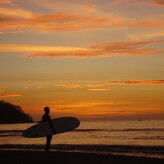Posts Tagged "become travel writer"
How I Broke Into Freelance Travel Writing

Breaking into freelance travel writing is not so different from breaking into other types of journalism. Start with small jobs, such as articles for your local newspaper, and gradually work your way up. As your portfolio builds, you can attach clippings of your past work to the pitches you make to editors. Markets that pay a dollar a word can offer a steady living as you get involved with press and media trips that take you across the world. As your list of clients grows, you can bolster your career by starting a blog and pitching book ideas to publishers such as Lonely Planet or Rough Guides. Finally, you become a Harvard professor and retire comfortably, living out the rest of your days sipping martinis on a private beach. Right?
While I’m not exactly qualified to cover the last two steps, I do make a comfortable living from freelance travel writing and can offer some sound advice for beginners. For starters, you need to learn how to tell a story and develop your own voice as a writer. Without a doubt, the best way to do this is to write stories about where you live. While this is much more exciting if you live in, say, San Francisco and not Chandler, Arizona, writing about the places you know offers a variety of perks. For one thing, you already know a bit of the history and culture and, if you’re lucky, you may know people who can give you an inside perspective on local events.
I got my start in travel writing by showcasing local theatres, restaurants, museums and hiking trails for newspapers in Asheville, North Carolina. While the pay wasn’t great, it got me thinking about how to describe places to my reader in an inventive way. It also gave me permission to be a tourist in my own home: asking questions about the architecture or noticing trends in cuisine and fashion that I normally wouldn’t. Even if my home town wasn’t such a mecca for artists and outdoor enthusiasts, I still would have managed to dig up hundreds of story ideas. It’s easy to forget that even in such glamorous destinations as Paris or Buenos Aires, there are still regular people living regular lives. While a local landmark or hiking trail may not be news to you, it still counts as a tourist destination for outsiders.
After publishing a few articles in the local paper, I began seeking out better-paying markets that specialize in travel. Thanks to the global recession and upward trends in internet publishing, many print markets have been driven out of business. Unfortunately, that includes thousands of regional magazines and newspapers that travel writers used to could count on for their income. Luckily, I caught this trend early and began to research magazines that had both an online and offline presence. The best of these include AFAR, American Way, BETA Magazine, and Backpacker, all of which pay up to a dollar a word.
Despite the steady rise in work, I began to feel as if I’d reached a plateau. Many of my editors wanted real-life experience in international destinations, and I had never left the country. Gradually I began to formulate plans for a three-month backpacking trip in Europe that included jaunts through Ireland, France, Italy and multitude of other countries. Since I wanted absolute freedom in my itinerary, I decided to save money on my own and shunned opportunities for media trips and tourism assignments that might have shouldered some of the cost. Until this point, it was still questionable whether or not I was a masochist. By now, the debate was settled. Needless to say, saving five thousand dollars on a beginner’s freelancing income was a miraculous feat, survived only with the help of bulk supplies of Ramen noodles.
Nevertheless, I saved the money and took out a credit card, and in early 2009 stepped aboard a plane to Ireland. I had pitched a few potential stories to editors, but my most important decision was starting a blog for daily travel updates. I can’t stress this enough for up-and-coming travel writers. Thanks to social networking sites such as Facebook and Twitter, travel bloggers can reach a wide audience of subscribers and keep them hooked. Some advice I wish I’d received early on was to think of my blog as a novel-in-progress. That means finishing each
entry with tomorrow’s itinerary, a question, or a tantalizing quote that keeps your readers coming back. This works the same way as cliff-hanger chapter endings in a novel, and your readers will faithfully clamor to read each day’s update.
Use your blog to help keep notes of descriptions and other details that you’ll want to remember when you’re writing later on, and always add images to complement your story. After learning these techniques and others, it wasn’t long before I developed an audience that couldn’t wait to hear what happened next in my journey. Later, when it came time to write a book, I used my blog entries to form the outlines and began condensing the different posts into chapters. I considered this a win-win situation: while I got to keep notes, garner exposure, and build a loyal following, my readers got to live vicariously through my experience. This is the key function of the travel writer. You are not only a storyteller, but a conveyor of excitements; boldly plundering each experience and passing it on to your reader in an effort to introduce them to the world outside their lives.
After three and a half months I returned to the States and got to work publishing articles for different markets. I used resources such as the Writer’s Market books and Craig’s List forums to find private clients, and began writing for online publishers such as Trails Travel, Golf Link, USAToday, and The Washington Times Communities. Thanks to some personal networking, I also began editing for travel publications such as Adventure Traveler Online, all while maintaining a healthy schedule of traveling and writing.
Before trying to break into freelance travel writing, it’s best to ask if the travel writer’s life is right for you. Do you love having freedom over your work schedule? Do you love visiting new places, and finding new ways to tell old stories? Do you feel a certain bravado about watching your day unfold on your own terms? If so, then it might be worth your time to take a stab at travel writing.
Read MoreWhat I Love About Being a Freelance Travel Writer

Like other freelance writers, I’ve always felt a slight feeling of nausea at the thought of working a nine-to-five job. Every day I wake up and go to my desk knowing that my creativity and articulation are the only things paying the bills. Although it can be a little frightening – especially during tax time – I find it exhilarating to watch the day unfold on my own terms. If a story isn’t making sense on paper, I just go for a hike or take a stroll to a local café and try again. If, at three AM, I get a great idea for a story, I send a quick e-mail to an editor and wake up the next morning to a brand new assignment.
Perhaps the biggest perk of being a travel writer is the license for guilt-free adventure. Whether it’s dancing with a local señorita or performing “detective work” at a neighborhood pub, being a travel writer gives you permission to experience each destination to its fullest. Contrary to popular belief, readers can sense when a writer is padding a story or using fluff clichés. I’ve heard more than one editor remark about tossing stories in the waste bin as soon as they see stock phrases such as “quaint”, “nestled”, or “resembling cardboard cutouts”. In other words: you have to truly experience the place you’re writing about if you want to write a good story.
As a freelance travel writer, your job is to find new places and tell new stories in a way that stains the reader’s imagination and makes them long to go where you’ve gone. I love this. It’s why I get out of bed in the morning. And because it’s nearly impossible to write an accurate, engaging story without experience, it forces me to get my head out of the guidebook and pay attention.
Which brings me to another reason why I love freelance travel writing. More than any other type of journalism, travel writing actually requires you to have a good time. I once tried to write a story about a weekend trip I spent in Dublin on the way to a writer’s conference. Due to logistical issues, I found myself constantly on the phone with conference staff and had no time for exploring the city. I was so preoccupied that I barely had a sip of Guinness in the airport before boarding my flight to Mali. Later, when I tried to write about my trip to Dublin, all I could summon were descriptions on how dreary the rain was.
One of my favorite trends in travel journalism is the recent boom in “experience tourism”. More and more readers are wanting stories about places that engage them both physically and mentally, with activities like ecotourism, volunteer work, and immersion. Instead of playing the role of tourist bystander, modern travelers are yearning to become important to the places they go. For me, this means even more opportunities to break the surface and connect with different people and their cultures. My favorite example of this is a week I spent volunteering at a work camp in Aix-en-Provence, France, that involved piecing together old Roman walls that had been buried for five centuries. After a day’s work everyone would reconvene on the patio for a bottle of du vin rouge while sharing our stories around a small fire pit. In addition to learning hands-on skills in masonry and excavation, my French vocabulary doubled, and I made some lasting friendships with the locals and other volunteers.
Thanks to conferences such as the annual New York Times Travel Show, travel writers can now talk directly with representatives of the tourism boards for different countries. Since practically every country profits from tourism, most travel shows have representatives just waiting to accommodate writers who can tell their story. One of my favorite aspects of travel writing is taking assignments from developing countries located in Africa, South America, Asia, or Eastern Europe. Since most readers are unfamiliar with these countries, you start to feel like you’re in unchartered territory. Why?
Because every travel writer and their cousin has written some blurb about cafés in Paris or coffeehouses in Amsterdam. But I don’t know anyone who’s written about, say, competing in an axe-throwing tournament in the Scottish Highlands, or witnessing a 2,000-year old shamanic ritual on an island in Lake Baikal, Russia. As a travel writer, you get paid to find that unique place or story and fully experience it with all your body.
And then comes the writing. With all of the allure and adventure of the job, it’s easy to forget that travel is only half of the job title. Being a travel writer means spending hundreds of hours crafting paragraphs and searching for the right words. It means sitting at your desk and revising stacks of pages for synapse and imagery, trying to find the best way to tell your stories. Fortunately, most successful travel writers have a passion for writing, and tend to find the act of filling pages to be as exhilarating as the traveling itself.
Of all the perks of the travel writer’s life, the writing is undoubtedly my favorite. It makes you see places and people in a different light, and keeps you searching for new ways to express yourself. As Natalie Goldberg famously said, writers live twice: experiencing each place one time in the flesh and another time on paper. I can’t imagine a better way to live.

